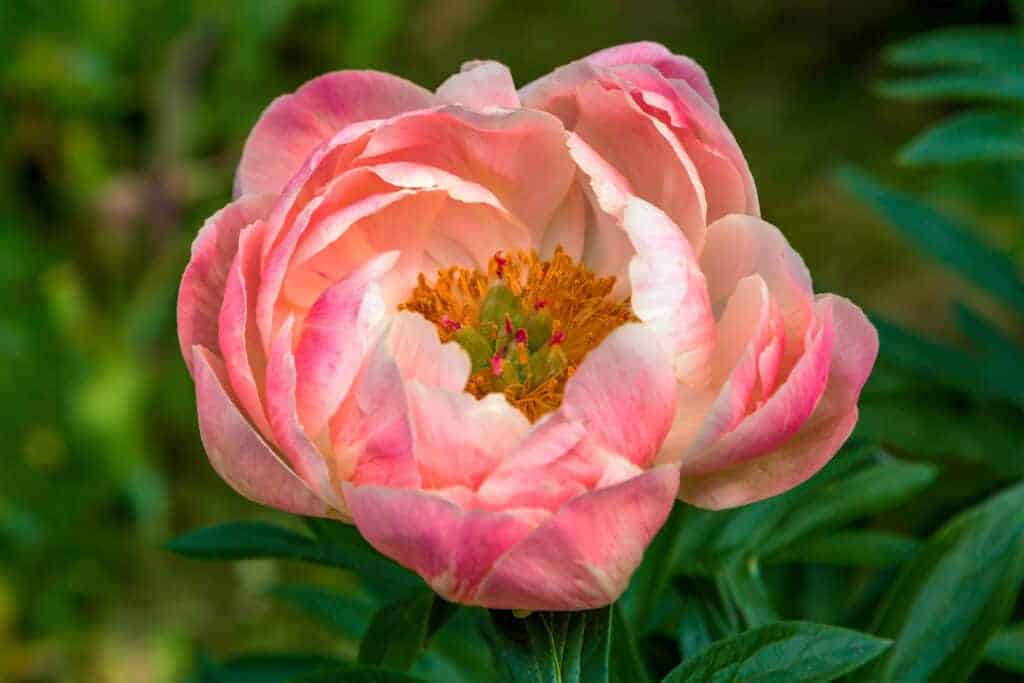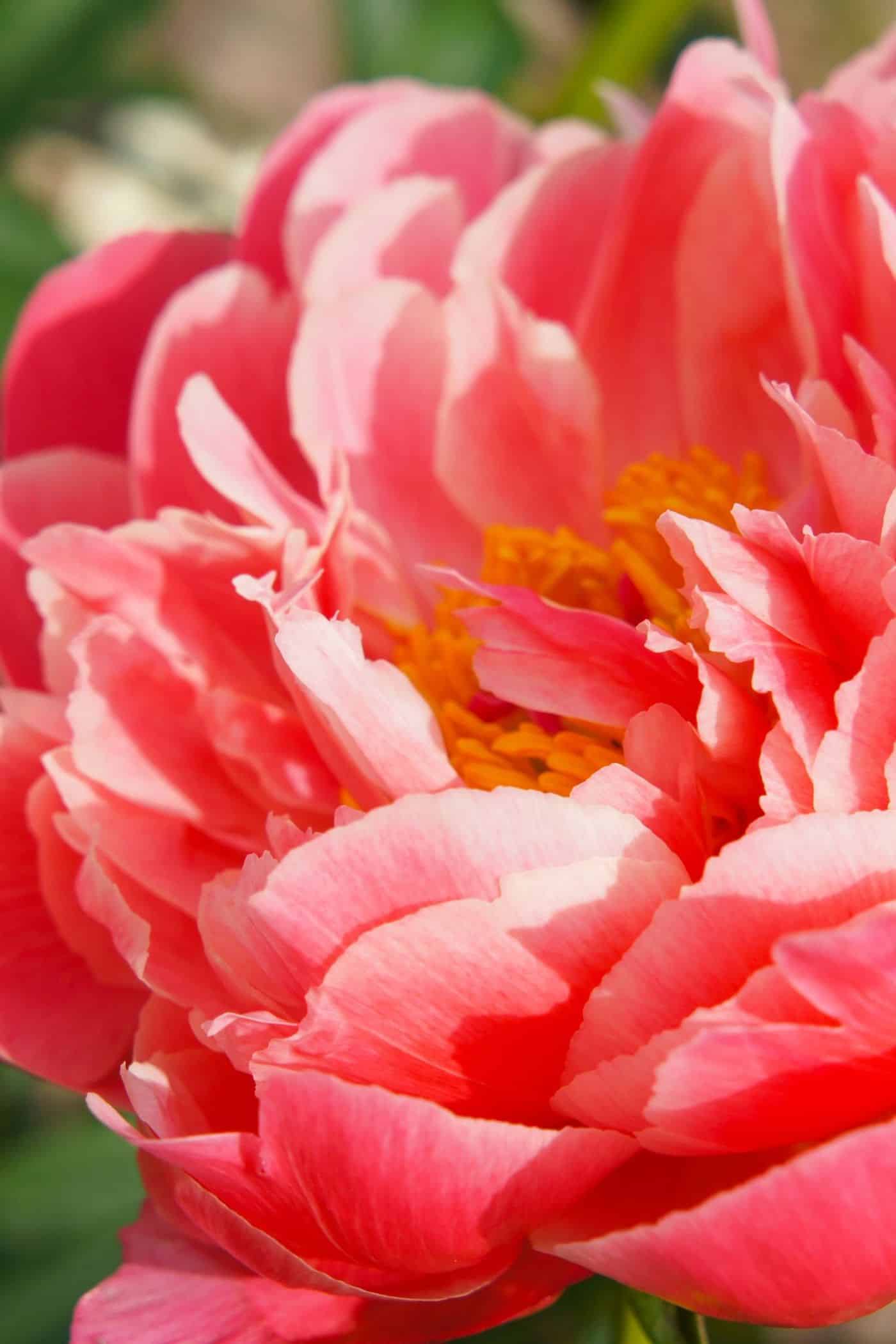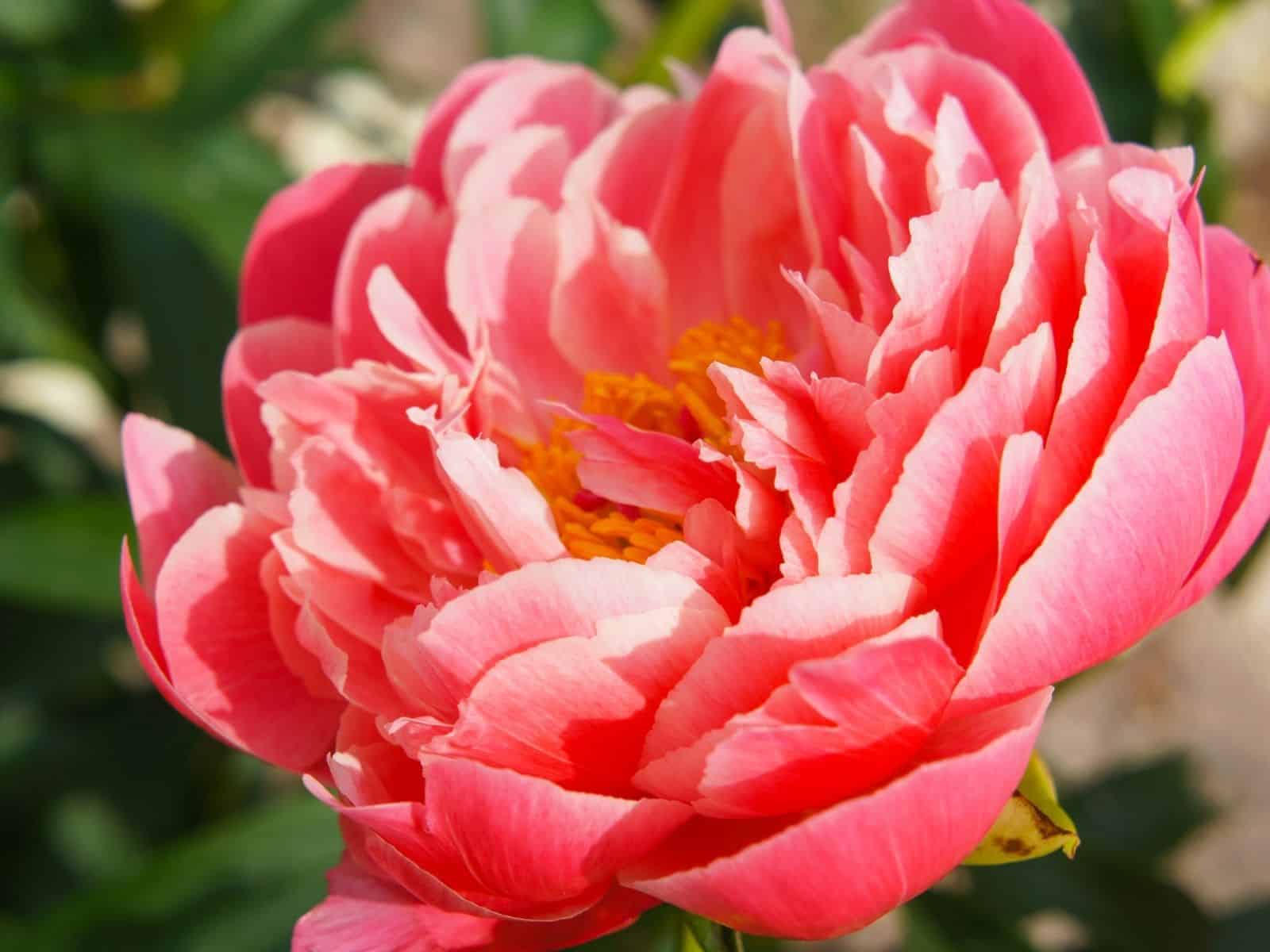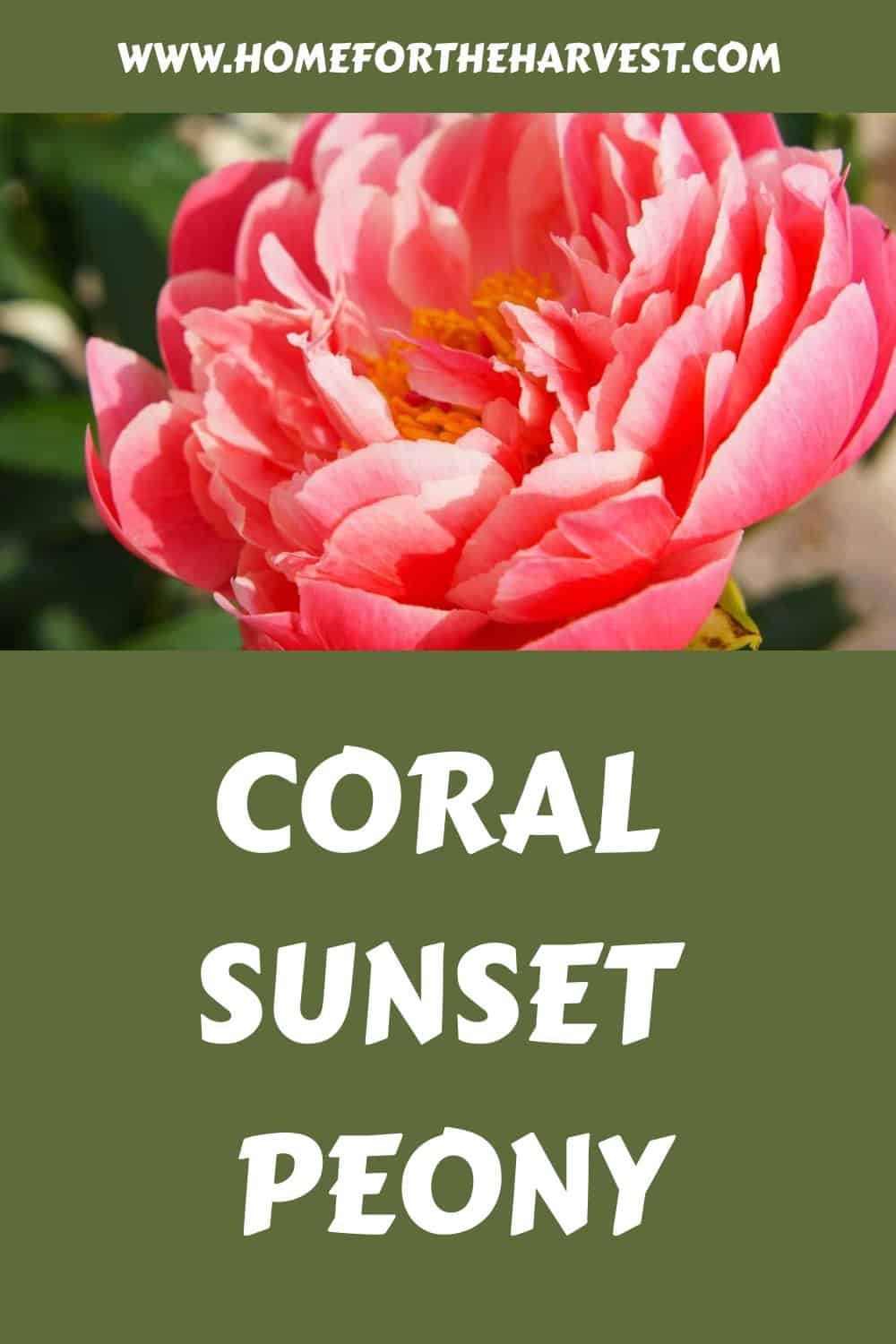Coral Sunset peony is a pink-orange peony variety with soft, bowl-shaped semi-double flowers. This variety has gorgeous yellow stamens, a lovely fragrance, and blooms early in the season. Plants grow about 30″-36″ tall, with an overall foliage width of 32″-36″ wide.
Samuel Wissing bred the Coral Sunset peony in the USA in 1965. It was introduced with Carl Klehm in 1981. The Coral Sunset peony is a hybrid Paeonia cultivar.
Coral Sunset peony basics
The Coral Sunset peony (Paeonia ‘Coral Sunset’) was hybridized by Samuel Wissing in 1965 and registered with Carl Klehm in 1981. This peony flower was named the 2003 Gold Medal Peony of the Year by the American Peony Society and went on to receive their Award of Landscape Merit in 2009. Samuel Wissing was also responsible for creating the Coral Charm peony.
The Coral Sunset is a semi-double type of peony. This means that it has a row of broad petals that are either single (just one layer) or double (two layers) that ring other broad petals intermingled with stamens. Blooms of an established Coral Sunset peony grow to be about 5″-6″ wide each.
This beautiful cultivar and Pink Hawaiian Coral peonies are perhaps the most well-known peonies in the coral family of peonies. The blooms are a vibrant coral hue with rose overtones when they first unfurl, aging to a cream-white in the sunshine as they reach full bloom.
In addition to their ornamental value in the garden, Coral Sunset peonies also make wonderful cut flowers with their fragrant blooms.
“The enormously popular ‘Coral Sunset’ opens a rich coral and fades to an antique cream over several days.”
Peonies, by Pamela McGeorge
Coral Sunset peony plants have very thick stems and ornamental green foliage with pointed leaves. At full-grown size, Coral Sunset plants are 30″-36″ tall and have a foliage width of 32″-36″ across.
Peony classification
Coral Sunset peonies (Paeonia ‘Coral Sunset’) are herbaceous perennial peony plants with semi-double peony flowers that bloom early in peony season. Peonies considered to be semi-double have more petal bulk than single-petal varieties but not as many interior transformed petals as a full double bloom.

Planting Coral Sunset peony plants
Coral Sunset peony plants can be planted in the early spring or in the fall. Typically, fall planting is preferred, but sometimes available supply necessitates spring planting. If planting peonies in the fall, try to get the roots into the ground at least six weeks before the ground freezes.
Choose the planting location wisely. Peonies have been known to live for 50 years or more. If they will be around that long, you will want to ensure they will be in the perfect spot!
Plant peonies in a location where the leaves will receive from the earth at least 6-8 hours of direct sunlight per day during the growing season. An area with well-drained soil is preferable, although peonies can tolerate clay soil if it is not waterlogged.
Coral Sunset Peony plants are sometimes sold as potted nursery plants in the spring but are most often sold as dormant bare-root peonies (which can be ordered year-round but generally ship in spring or fall).
Potted nursery plants are easy to plant simply by digging a wide hole no deeper than the soil in the pot. Here is a video showing how to plant potted peonies in the garden:
Bare root peonies should be soaked in clean water for an hour or two prior to planting. Look for the white/pink “eye” buds on the top of the root. Be sure to place the eyes so they are pointing upwards towards the sky, as they will become the stems.
The “eyes” should be about 1″ below the soil surface. Coral Sunset peonies can have trouble blooming if the eye buds are lower than 2″ below the top of the soil. Here is a video showing how to plant bare-root peonies:
When planted in groups, peony plants should be about 3 feet apart. They can get large and almost shrub-like. If you plant them too close to each other, the plants become stressed, and diseases can take them out. Just like humans, flowers also need sufficient air to breathe. Spacing them out properly will ensure that your plant can live for a long time. When planting bare-root peonies, the same instructions apply. Avoid windy areas.
How to grow Coral Sunset peony plants
Coral Sunset peony plants are low-maintenance and generally quite easy to grow, especially once their roots have become well-established in the surrounding potting soil. A Coral Sunset peony is considered a herbaceous peony, with the foliage dying back to the ground in the winter and sprouting anew in early spring. Coral Sunset peony plants can be grown in hardiness Zones 3-8 (and potentially even down to Zone 2).
While this cultivar has thick stems, Coral Sunset peony plants sometimes need to be staked or supported, especially in windy or rainy climates. The easiest way to support a Coral Sunset peony is with a peony support ring. Place it early in the season to allow the stems to grow through the support in a natural fashion.
Water your Coral Sunset peonies with an inch of water every week (unless rainfall provides that amount). If they do not get enough water, they will not grow properly and you will have wasted your time. These plants will first bloom in late spring and early summer.
It will take them 7 to 10 days to fully flower. It’s best to mix them in with other varieties of peonies that bloom later in the summer so that you always have beautiful flowers around your garden
Peonies can be fertilized in spring when the stems are about a foot high. The leaves should just be starting to unfurl at this point, and tiny flower buds may be visible. Apply a high-quality organic fertilizer according to the directions on the package.
After peonies have bloomed, remove the spent blooms from the plants with pruners. Try to remove as few of the leaves as possible. This is because foliage is important for photosynthesis, so the plant can make and store plant food to survive the winter with enough energy to sprout in the spring. A nicely-trimmed peony looks like a small foliage shrub during the summer, turning yellow-red in autumn as the weather cools.

Pests and other problems
For the most part, Coral Sunset peonies and most other varieties of peonies are very resistant to diseases and pests, but that doesn’t mean you can let your guard down. There are a few dangers that you should always be watching out for so that you can catch the problem early and make changes to prevent the death of the flower.
The most common problem you are likely to encounter is a fungal disease. These will happen as a result of moisture build-up.
Botrytis blight is one common type of fungal disease you may encounter. It will attack all parts of the peony, the stem, leaves, and buds. It leaves the plant covered in fuzzy mold and causes dark spots.
To treat fungal diseases on a peony, you should mix baking soda, horticultural oil, and dish soap. There are many varieties of this mixture, but it should help. Add it all in a water mixture and spray it on your peonies to help fight it off.
In the end, it is hard to get fungal diseases to go away once they start, so it is best to use preventative techniques so that you don’t have to start treating them! Be sure to do really good fall prep before the cold months so that moisture doesn’t build up and leaves places for mold.
Another disease you may encounter with this peony is nematodes. These are microscopic worms that burrow into the plant and can cause discoloration and potentially lead to plant death.
To help prevent it, try not to move the peonies too much and do not splash the leaves with water. Put your peonies with healthy plants so that diseases don’t spread.
With proper prevention and care, your peonies can look good for years to come if you keep up with them. These diseases may never be a problem for you if you keep an eye out and try to care for your plant in all stages of life.







